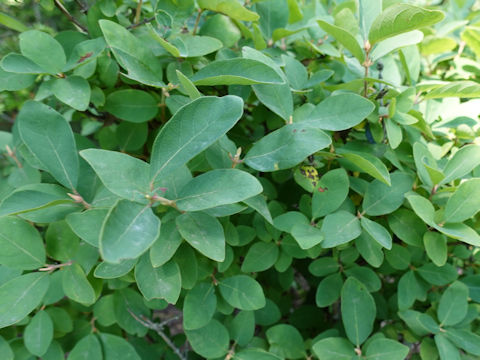|
|
|
|
[Index]
[Back] |
    |
|
|
|
わが国の本州、中部地方以北から北海道、千島列島、サハリン、朝鮮半島それに中国東北部に分布しています。平地から亜高山帯に生え、高さは1〜2メートルになります。葉は楕円形で対生し、全縁、両面に毛があるかまたは無毛です。5月から6月ごろ、葉腋の短い花柄の先に、黄白色で漏斗形の花を2個咲かせます。果実は楕円形から球形の液果で合着して複合果となり、長さ12〜15ミリ、8月から9月に熟して、粉白を帯びた黒紫色になります。果実には甘味があり、ジャムや、果実酒、お菓子などの加工用としても栽培されています。中国語では「藍果忍冬(lan guo ren dong)」と呼ばれます。 別名の「はすかっぷ」は、アイヌ語でこの植物の果実を指す呼び名の「ハシカプ(has-kap)」に由来します。また「はすかっぷ」という名前は、この母種とされる高山性の「けよのみ(毛ヨノミ)」にも使われます。 写真上・中1は、園芸品種の「カイドウ(cv. Kaido)」、 中2は、「クチ(cv. Kuchi)」、 下は、「マキシンズオウパス(cv. Maxine's Opus)」。 |
|
|
スイカズラ科スイカズラ属の落葉低木で、学名は Lonicera caerulea ssp. edulis var. emphyllocalyx (syn. Lonicera caerulea var. emphyllocalyx)。英名は Japanese haskap、Blue honeysuckle、Honeyberry。 |
|
|
The Japanese haskap (Lonicera caerulea ssp. edulis var. emphyllocalyx) belongs to Caprifoliaceae (the Honeysuckle family). It is a small deciduous tree that is distributed from Chubu regions of Honshu northward to Hokkaido in Japan, as well as the Kuril Islands, Sakhalin, the Korean Peninsula, and northeastern China. It grows from plains to subalpine zones and is 1 to 2 m tall. The leaves are elliptic, opposite, entire, and hairy or hairless on both sides. The 2 yellowish-white, funnel-shaped flowers bloom from May to June at the tips of short peduncles in the leaf axils. The fruit is an elliptic to spherical berry that connates to form a compound fruit, 12 to 15 mm long, ripening from August to September and turning a powdery blackish purple color. The fruit has a sweet taste and is cultivated for jam, fruit wine, confectionery, and other processing uses. In Chinese, it is called "藍果忍冬" (lan guo ren dong). The other name "Haskap" comes from the Ainu word "has-kap", which refers to the fruit of this plant. The name "Haskap" is also used for the alpine "Ke-yonomi" (Lonicera caerulea ssp. edulis), which is considered to be the mother species of this plant. |
|
|
アメリカ・ケンタッキー州「ユーデル植物園」にて、2024年05月19日撮影。(photo by Jon Suehiro) |
|
|
|
Shu Suehiro |